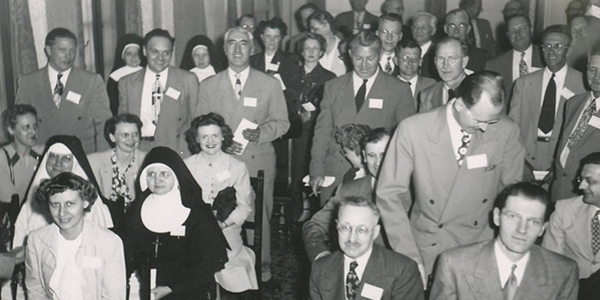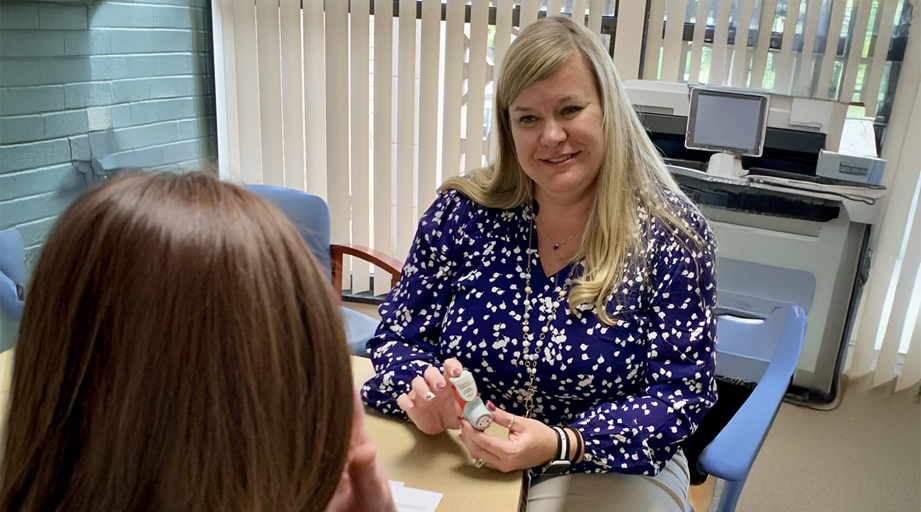
 The House of Delegates (HOD) will mark its 75-year anniversary at the ASHP Summer Meetings in Baltimore, Maryland. That’s 75 years of making policies that have helped shape ASHP — and the pharmacy profession.
The House of Delegates (HOD) will mark its 75-year anniversary at the ASHP Summer Meetings in Baltimore, Maryland. That’s 75 years of making policies that have helped shape ASHP — and the pharmacy profession.
“The professional policies deliberated by the ASHP House of Delegates have played a vital role in advancing patient care and pharmacy practice for 75 years now,” said Kasey K. Thompson, ASHP’s chief operating officer and senior vice president. “The exceptional ASHP members who have served in the House are truly amazing, and their passion for achieving ASHP’s vision for medication use to be optimal, safe, and effective for all people all of the time is inspirational. The positive impact on public health and patient care that members of the ASHP House have made through the development of ASHP professional policies and through their leadership to translate those policies into practice is unquestionable.”
Here are just a few notable decisions over the decades.
Therapeutic Interchange — 1987
By the mid-1980s, therapeutic interchange by pharmacists was increasingly prevalent in hospitals, yet it remained controversial among organizations representing physicians and drug makers. In Washington state, for example, the pharmaceutical industry lobbied unsuccessfully for a bill that would have eliminated the role of the pharmacist in therapeutic interchange.
At issue was a lack of consensus over what the concept meant in practice. ASHP’s Council on Legal and Public Affairs urged delegates to adopt a definition making clear that pharmacists were not asking to act alone, but in concert with prescribers. The concept approved by the House became a model for other organizations, including the American Pharmacists Association and the American Association of Colleges of Pharmacy, which adopted similar positions.
“Many pharmacists today are qualified to participate in therapeutic interchange; given the direction of pharmaceutical education, this service will be well within the capacity of most pharmacists in the future,” then-editor of AJHP, William Zellmer, wrote in March 1988.

Medical Aid in Dying — 1999 and 2017
ASHP first began studying medical aid in dying, then more typically called assisted suicide, in the early 1990s. The House declined to vote on policy recommendations put forth by the Council on Legal and Public Affairs. However, the issue increasingly landed in the public eye following two Supreme Court cases on the issue, as well as ballot initiatives in several states. An ASHP task force was appointed to consider policy options. The HOD in 1999 used that report to approve a policy calling for ASHP’s neutrality on the matter.
“It neither condones nor condemns participation in assisted suicide,” according to a commentary published by council members in AJHP in 1999. “It is an attempt to balance the patient’s right to autonomy with the pharmacists’ right to conscientious objection.”
By 2017, more than 20% of Americans had medical aid in dying as a legal end-of-life option where they lived. Intense public debate surrounded efforts to legalize the option in statehouses, and professional organizations were divided. ASHP House delegates were ready to take another look at pharmacist participation.
A joint council task force was convened to review the existing policy. The task force recommended first to cease using the phrase “assisted suicide” in favor of “medical aid in dying.” And it urged a policy of “studied neutrality” on laws permitting medical aid in dying for competent patients with a terminal illness.
Studied neutrality was defined as “the careful or premeditated practice of being neutral in a dispute,” with goals “to foster a respectful culture among people of diverse views and to guide action that does not afford material advantage to a [particular] group.”
In an August 2017 editorial in AJHP, Daniel J. Cobaugh, editor in chief, noted that the policy would not resolve the differences among members on such a difficult issue. “However, ASHP ‘got it right’ on both the process used to develop the policy and a position of studied neutrality that effectively balances patients’ rights to autonomy and self-determination with individual pharmacists’ rights to make conscience-based decision,” he wrote.
Medication-Use Safety — 1986 and Beyond
In 1999, the Institute of Medicine released its groundbreaking To Err is Human: Building a Safer Health System, a report widely credited with calling national attention to medical errors.
But nearly 15 years before that report’s release, ASHP’s House had already been prioritizing medication safety.
Delegates in 1986 approved a resolution urging, in part, that “the subject of medication errors” be included in ASHP’s publications and educational programs. The resolution was prompted by several tragedies that year resulting from medication errors in hospitals.
The HOD’s emphasis on preventing medication errors continued to grow and included such policies as:
- Supporting the concept of a multidisciplinary reporting system for errors (1992)
- Urging pharmacists to establish a “non-threatening, confidential” workplace atmosphere to encourage staff to report adverse drug events in a timely manner (1996)
- Calling for pharmacists to be included in healthcare organizations’ risk management processes, partly to review occurrences of medication errors and develop corrective actions (2000)
Those policies helped spur multiple initiatives over the years. In 1998, for instance, ASHP helped form the Coalition for Quality in Medication Use to provide the federal government with performance measures. Last year, delegates passed a policy on autoverification of medication orders. At the HOD session in Baltimore, delegates will debate a policy on removal of injectable promethazine from hospital formularies.

Pharmacist Prescribing
At least as early as 1982, the ASHP House began supporting prescribing by pharmacists. That year delegates adopted a report from the Council on Clinical Affairs, which described pharmacist prescribing as a “complex and controversial” authority but one that could be done under carefully spelled-out protocols and in an organized setting, such as a hospital.
Twelve years later, amid vigorous debate of President Clinton’s national healthcare proposal, the HOD voted to pursue the development of legislative and regulatory provisions that allowed for prescribing. In its 1994 report, the Council on Professional Affairs said the old policy on the subject was too simplistic. “To take advantage of the opportunities presented by healthcare reform, this policy also needed to be revamped to take on a more proactive posture,” the council’s report said.
The report, adopted by the HOD, suggested the development of education materials on the pharmacist’s role in prescribing and in pharmaceutical care in general. The report also noted that patients have easier access to pharmacists than other healthcare providers — a point ASHP continues to make as it works on new provider status legislation.
As pharmacist prescribing grew, the policies pursued by the House turned increasingly detailed over the years. Last year, for instance, the House approved the ASHP policy Pharmacist Prescribing in Interprofessional Patient Care. That policy calls, in part, for all pharmacists on an interprofessional patient care team to have a National Provider Identifier recognized by payers. Nearly all states now include varying levels of pharmacist prescribing authority.
Taking on Big Issues — Before They Become Big
The House of Delegates doesn’t shy away from controversial issues. In fact, delegates at times have debated topics before they routinely make headlines.
Take, for example, the 2017 policy entitled Therapeutic and Psychosocial Consideration of Transgender Patients. That policy called for ASHP to support medication and disease management of transgender patients; promote research on therapeutic and biopsychosocial best practices in the care of transgender patients; and encourage “structured documentation” of both a patient’s birth sex and self-identified gender in electronic health records.
“Because of the unique and complex healthcare needs of transgender patients, it is essential that they have adequate access to appropriate care, including pharmacist care,” the Council on Therapeutics wrote in its report. (Delegates will consider updates to that policy at their June meeting in Baltimore.)
And while interest in increasingly powerful artificial intelligence (AI) technology exploded recently with the debut of ChatGPT, ASHP delegates signed off on an AI policy statement three years ago. That 2020 statement says, in part, that pharmacists should lead the design, implementation, and ongoing evaluation of AI-related technologies that affect medication use.








